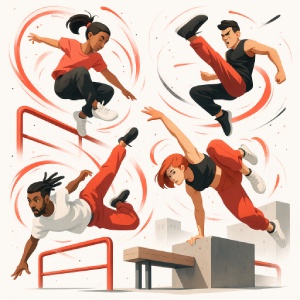What Is Tricking?
Tricking is a mobile hybrid art that makes heavy use of martial arts such as Taekwondo, Capoeira, and Wushu, borrowing acrobatics from gymnastics and stylistic flair from breakdance. It is not a physical combat dance but more one of self-expression and physical accomplishment. Movement sequences include feats of speedy kicks, flips, and twists executed with respectability and artistic integrity.
Even if tricking has only recently been considered an activity in its own right, its roots go quite far back. Martial artists explored flashy kicks to show their prowess; gymnasts took twists and acquired aerial awareness, and dancers infused flow and rhythm. Today, tricking has turned into a global community where athletes perform solo or in showcases and often record themselves on video for an online audience or competition.
The Origins of Tricking

Tricking began to emerge in the 1990s in the United States and Europe, heavily influenced by the martial arts demonstrations and the popularity extremes sports witnessed at the time. It started to form with credentialed martial artists who combined those beautiful kicks with farcical gymnastics flips and spins straight out of breakdance to achieve their own artistry, as much for its aesthetic value as for combat value.
Communities formed around the concept of pushing physical and metaphorical boundaries: air recognition, sound understanding of rhythm, and all-out physical strength. Early trickers often met in gyms, parks, and homes to train informally, creating an underground culture of experimentation. Today, a much broader platform exists online-the tricking community shares tricks and choreographies worldwide.
Core Elements of Tricking
The three main movements traditionally considered in tricking are kick, flip, and twist. The three can be broken down even further to allow the athlete and performer to branch from simple moves to complex combinations.
- Kicks: Tricking incorporates martial arts kicks such as the roundhouse, tornado, and 540 kicks, often adding extra spins or rotations just for show.
- Flips: Gymnastic flips such as backflips, front flips, and corkscrews serve to build that vital aerial awareness.
- Twists: Rotational work makes tricking more complex and captivating thoughts to 360 twists or flips combined with twists.
Basically, a tricking concept called flow enables the easy blending of several moves into one continuous series. Flow demands not only technical prowess but the spatial awareness, timing, and rhythm capabilities.
Beginner Tricking Techniques
Starting with basic moves for smooth transition will be necessary for safety and success. The beginner needs to concentrate on learning fundamental kicking technique and some easy aerial awareness drills and flips that have less risk.
- Opening Kicks: Adopt controlled roundhouse kicks, front kicks, and side kicks. Balance, form, and even the heights would slowly be emphasized. Warm-up and stretching-related activities prevent injuries to the hamstring or hips.
- Introductory Flips: Gymnastic or dive rolls and back or front flips done on mats or soft surfaces enable beginners to comprehend the aerial rotation mechanism while avoiding the stress of rotation on the joints. Whether it is through manual spotting or padded equipment, a spotter is necessary.
- Twist Preparation: Body control on rotational drills, such as small spins or tuck jumps, shall serve as development towards another set of more challenging airborne rotations. Early spotting emphasis (head and eye directions during rotations) increases safety and success rates.
Intermediate Tricking Techniques
Once the foundation skills are firmly set, intermediate trickers venture into kicks with spins, aerial combos, and multi-axis flips.
- Spinning Kicks: A tornado kick and a spinning hook kick are spin-type attacks that use centrifugal force for striking. Timing them properly, therefore, develops your core strength and coordination. Practicing them slowly first and then gradually ushering speed will ideally lessen injuries.
- Aerial Combinations: Adding flips to kicks beautifies and complicates them. For example, performing a roundhouse kick and then going into a backflip or perhaps carrying out a front flip with a twist. Aerial combos require strength and precise body control.
- Twist Incorporation: Among intermediate trickers during their routine practice are corkscrew rotations or 360-degree flips. These require a strong core and good spatial awareness as their landings need consistency to keep up with the flow or else they will stumble.

Advanced Tricking Techniques
Advanced-level tricking methods test the human body by combining many kicks, flips, and twists into complex and aesthetically greatest-performing sequences.
- Multi-Kick Combos: These involve sequences of two to three kicks with rotations executed simultaneously and thus are the most complex from a visual and athletic standpoint. They demand explosive leg strength, perfect timing, and good landing techniques.
- Flips and Twists: A kick such as the 720 kick (kick given while executing two full spins) or a double backflip is accomplished when the practitioner attains a high level of aerial control. Practitioners stand to develop these full sequences by working backward with progressively more challenging drills and spotters.
- Freestyle Flow: At the highest level, tricking becomes improvisational performance, incorporating rhythm, creativity, and personal style. Athletes learn to adapt sequences dynamically, combining tricks into endless variations for showcases or competitions.
Training Principles for Tricking
Effective training of tricking blends strength, flexibility, aerial awareness, and mental focus.
- Strength and Conditioning: Core, leg, and upper-body strength are essential. Having the big four-lunges, squats, push-ups, and core stabilization drills-will assist with power, balance, and jump height. Plyometrics help develop the explosive power required for flips and aerial kicks.
- Flexibility and Mobility: Hip and hamstring flexibility are needed for high kicks and extended flips. Dynamic stretching before training and static stretching afterward help maintain mobility while preventing injury.
- Mental Training: Premiership is given to confidence, visualization, and focus as with physio training. One can mentally rehearse moves, spot landings, and ease oneself into difficulty, building safety as well as skills.
Safety and Injury Prevention
Since tricking is all high-impact and aerial moves, safety should truly come first.
- Progressive Training: Always go into higher difficulty tricks progressively and never before mastering one's fundamentals, as this will inculcate more falls and injuries upon joints.
- Equipment: Use padded mats, foam pits, or training facilities made for acrobatics. Wrist guards, ankle supports, and suitable footwear add to one's personal safety.
- Supervision and Spotting: Novices should remain under supervision, either by seasoned trickers, coaches, or their training partners. Spotting during flips and rotations helps land more safely and reinforces the correct techniques. Good spotting is crucial to build mental confidence when learning new skills.
Tricking as a Complement to Other Disciplines

Tricking can be said to be a performance enhancer for movement arts like parkour and calisthenics.
- Integration with Parkour: Tricking is used to bring stylistic flourishes and creativity to the otherwise more grounded movements of parkour. Adding flips or kicks to vaults, wall runs, or drops increases the visual impact and helps enhance aerial awareness.
- Integrated with Calisthenics: The strength, core control, and flexibility gained through calisthenics aid in improving tricking technique. Pull-ups, dips, and other bodyweight exercises provide upper-body and core strength, which forms the foundation of all explosive aerial maneuvers.
- Creative Expression: Beyond technical skills, mash-ups allow practitioners to go into atypical movement patterns, turning any mundane space into a ground for creative performances.
Community and Culture
A worldwide, cooperative community exists for tricking that lies primarily in creativity and personal expression. Athletes share tutorials, progressions, and freestyle sequences across the internet for further development and innovation. Events remain showcases with local gatherings for everyone else to learn, perform, and socialize.
The culture places great emphasis on being experimental and inclusive. Beginners face no barriers to experimentation with their own styles; intermediates apply their style; and advanced practitioners continue to innovate on the fundamental language so that it keeps evolving and dynamic.
The Art of Dynamic Movement
Tricking is a captivating yet interesting amalgamation of martial arts, gymnastics, and dance that serves as both a test of athleticism and an art form. From simple kicks to complicated double-leg aerial twists, the exercise builds strength, flexibility, and body awareness; meanwhile, it also encourages one to think creatively with their style. Safe tricking practices, alongside variations in difficulty levels, coupled with cross-training in disciplines such as parkour and calisthenics, offer the maximum dividend. Consequently, tricking means more than just acquiring the skill to perform a move; it translates to mastering the art of movement that is expressively functional and eye-catching. Learn more at 3RUN.